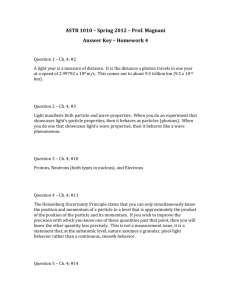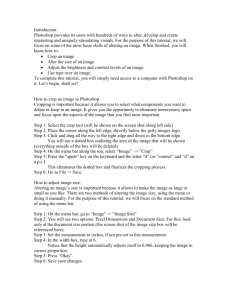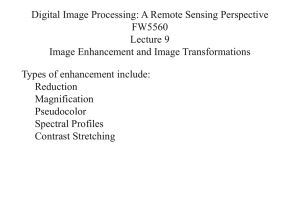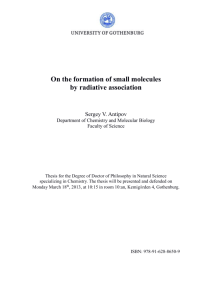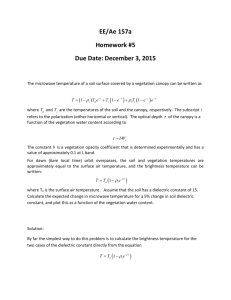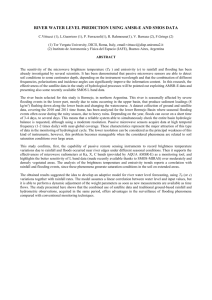Matlab Calculation Software for the Temperature Resolution
advertisement
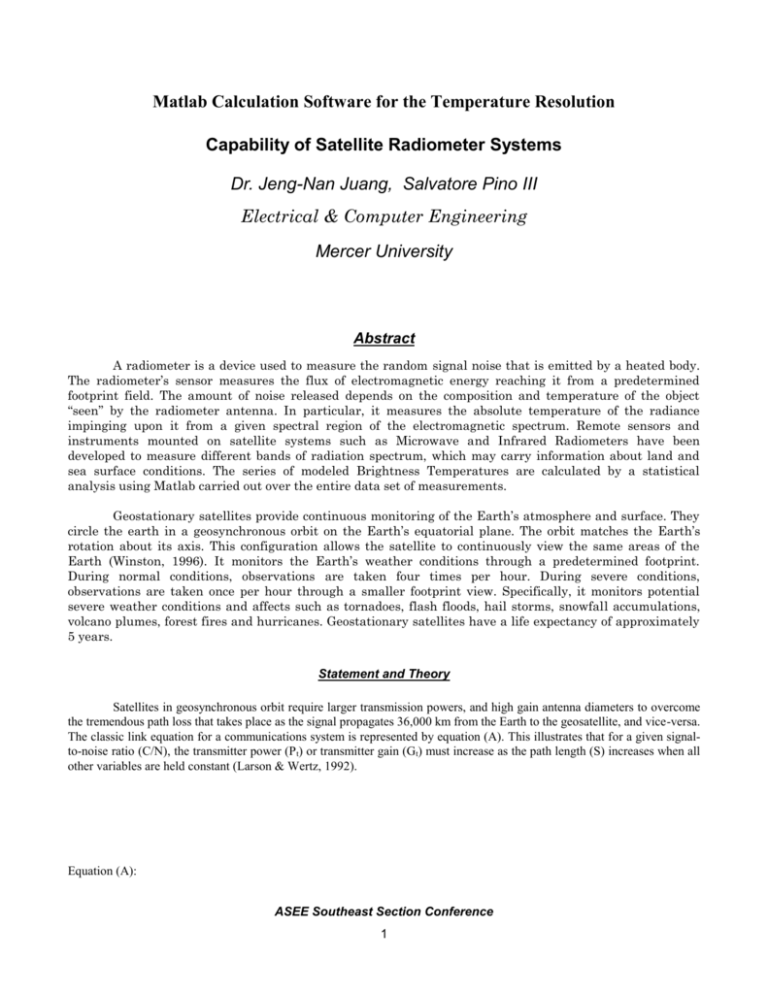
Matlab Calculation Software for the Temperature Resolution Capability of Satellite Radiometer Systems Dr. Jeng-Nan Juang, Salvatore Pino III Electrical & Computer Engineering Mercer University Abstract A radiometer is a device used to measure the random signal noise that is emitted by a heated body. The radiometer’s sensor measures the flux of electromagnetic energy reaching it from a predetermined footprint field. The amount of noise released depends on the composition and temperature of the object “seen” by the radiometer antenna. In particular, it measures the absolute temperature of the radiance impinging upon it from a given spectral region of the electromagnetic spectrum. Remote sensors and instruments mounted on satellite systems such as Microwave and Infrared Radiometers have been developed to measure different bands of radiation spectrum, which may carry information about land and sea surface conditions. The series of modeled Brightness Temperatures are calculated by a statistical analysis using Matlab carried out over the entire data set of measurements. Geostationary satellites provide continuous monitoring of the Earth’s atmosphere and surface. They circle the earth in a geosynchronous orbit on the Earth’s equatorial plane. The orbit matches the Earth’s rotation about its axis. This configuration allows the satellite to continuously view the same areas of the Earth (Winston, 1996). It monitors the Earth’s weather conditions through a predetermined footprint. During normal conditions, observations are taken four times per hour. During severe conditions, observations are taken once per hour through a smaller footprint view. Specifically, it monitors potential severe weather conditions and affects such as tornadoes, flash floods, hail storms, snowfall accumulations, volcano plumes, forest fires and hurricanes. Geostationary satellites have a life expectancy of approximately 5 years. Statement and Theory Satellites in geosynchronous orbit require larger transmission powers, and high gain antenna diameters to overcome the tremendous path loss that takes place as the signal propagates 36,000 km from the Earth to the geosatellite, and vice-versa. The classic link equation for a communications system is represented by equation (A). This illustrates that for a given signalto-noise ratio (C/N), the transmitter power (P t) or transmitter gain (Gt) must increase as the path length (S) increases when all other variables are held constant (Larson & Wertz, 1992). Equation (A): ASEE Southeast Section Conference 1 C/N = [(Pt)(Gt)(Gr)/kTf]]/4S Gr is the receiver gain k is the Boltzman constant; 1.380658 x 10 T is the system temperature f is the receiver bandwidth; the wavelength of the signal Brightness Temperature Brightness Temperature is defined as the amount of radiated energy that is emitted from an object. The brightness temperatures are calibrated by the “tipping curve” calibration procedure (Decker and Schroeder, 1991). The equation to derive atmospheric brightness temperature from the measured voltages and internal temperature is represented by Equation (B). This yields the brightness temperature, T b. Equation (B): V Vr Th Tr X 1 Tr Tw Tw Tb X 1 m Vh Vr X1 is a loss factor Tw is the temperature of the water vapor in the instrument’s elevation angle (K) Tr is the temperature of the black body “load” (K) Th is the temperature of the hot black body (K) Vr, Vh, and Vm are dc voltage outputs that are proportional to the input power To establish a relationship between the brightness temperature and air mass, the brightness temperature at each elevation angle is converted to total absorption, which is linear with mass. This is achieved by using Equation (C) (Wilkinson, 1986). This yields the total absorption, τ. ASEE Southeast Section Conference 2 Equation (C): T T mr bg ln Tmr Tb Tmr is the mean radiating temperature (K) Tb is the brightness temperature of the atmosphere (K) Tbg is the cosmic background radiation; 2.75 K for Tbg Radiative Transfer Equation Radiative Transfer is defined as the process of transmission of the electromagnetic radiation through the atmosphere. The brightness temperature equation that will be used to generate data is to use the height profiles of temperature, water, vapor, and pressure. This is done by evaluating the Radiative Transfer Equation in Equation (D). This equation requires the use of numerical methods for evaluation and it is given by Schroeder and Westwater (1991) Equation (D): h I v Tb , B Tbg exp B T h h exp h'dh' dh 0 0 Tb,v is the brightness temperature (K) at frequency ν Iv(Tb,v) is the radiance (W m-2 sr-1 GHz-1) H is the height (Km) T = T(h) is the temperature (K) at height h Bv(T) is the planck function (W m-2 sr-1GHz-1) αν=αν(h) is the absorption coefficient (km-1) Bν(T) = C1V3/[exp C2V/T-1] (mW/m2/ster/cm-1) V = # wavelengths in one centimeter (cm-1) T = temperature of emitting surface (K) C1 = 1.191066x10-5 (mW/m2/ster/cm-4) C2 = 1.438833 (cm K) ASEE Southeast Section Conference 3 Statement of the Problem The radiometer must resolve temperature changes from one resolution cell to the next when the temperature changes are subjected to a wide variation over its field of view. It must resolve absolute temperatures with a small absolute error to yield accurate tracking data. This paper attempts to prove that using the Radiative Transfer Equation will yield lower brightness temperature, thus improving the accuracy of space radiometers. The main area of concentration is to generate a computer program using Matlab to solve Equation (D). The calculated data from the Radiative Transfer Equation will be compared to the known Brightness Temperatures from the Brightness Temperature Equation at 20.6 GHz, 31.65 GHz and 90.0 GHz. The results will be summarized in Tables 1, 2, and 3. Additionally, there is a plot in Figure 3 that represents the comparison of the results using the Radiative Transfer Equation to the Brightness Temperature Equation at 20.6 GHz. Data The series of modeled Brightness Temperatures are calculated by a statistical analysis using Matlab carried out over the entire data set of measurements. The results using the radiative Transfer Equation are compared to the RTE76, RTE87, and RTE93 models. The results are shown in Figure 1. TEMPERATURE (KELVIN) Table 1 contains the 209 generated data using the Radiative Transfer Equation during the first hour and Table 2 contains the 209 generated data using the Radiative Transfer Equation during the last hour. Tables 3, 4, and 5 contain a summary of the results. Figure 1. Radiative Transfer Equation (D) results plotted against the RTE76, RTE87, and RTE93 models over a 12Hour Period at 20.6 GHz. Table 1. The 209 generated data points during the first hour ASEE Southeast Section Conference 4 26.699 26.710 26.720 26.730 26.740 26.750 26.760 26.770 26.780 26.790 26.800 26.810 26.820 26.830 26.840 26.850 26.860 26.870 26.880 26.890 26.900 26.920 26.940 26.960 26.90 27.000 27.050 27.100 27.133 27.200 27.225 27.230 27.250 27.280 27.300 27.320 27.350 27.380 27.399 27.390 27.380 27.370 27.360 27.350 27.340 27.330 27.320 27.310 27.300 27.290 27.274 27.266 27.260 27.250 27.240 27.230 27.210 27.200 27.190 27.166 27.180 27.190 27.215 27.232 27.254 27.277 27.284 27.299 27.320 27.360 27.374 27.380 27.399 27.390 27.386 27.380 27.373 27.370 27.368 27.366 27.364 27.360 27.358 27.356 27.352 27.340 27.320 27.310 27.300 27.250 27.200 27.150 27.100 27.095 27.080 27.070 27.060 27.050 27.040 27.030 27.020 27.010 27.005 27.000 27.010 27.030 27.045 27.060 27.075 27.090 27.105 27.115 27.130 27.145 27.160 27.175 27.190 27.205 27.215 27.230 27.245 27.260 27.270 27.275 27.280 27.290 27.292 27.295 27.266 27.300 27.300 27.295 27.290 27.280 27.276 27.270 27.260 27.245 27.230 27.215 27.205 27.190 27.175 27.160 27.145 27.130 27.115 27.105 27.090 27.075 27.060 27.045 27.030 27.015 27.000 26.991 26.993 26.999 27.010 27.020 27.030 27.050 27.062 27.050 27.042 27.040 27.000 26.990 26.980 26.970 26.960 26.950 26.940 26.930 26.925 26.920 26.915 26.900 26.895 26.890 26.885 26.866 26.900 26.912 26.916 26.900 26.880 26.870 26.860 26.850 26.840 26.830 26.820 26.810 26.800 26.790 26.780 26.770 26.760 26.750 26.740 26.730 26.720 26.710 26.710 26.705 26.701 26.699 26.699 Table 2. The 209 generated data points during the last hour ASEE Southeast Section Conference 5 21.332 21.335 21.343 21.360 21.370 21.390 21.400 21.410 21.430 21.450 21.470 21.480 21.491 21.500 21.515 21.525 21.532 21.546 21.574 21.600 21.613 21.629 21.642 21.660 21.682 21.699 21.700 21.715 21.723 21.731 21.743 21.758 21.772 21.783 21.789 21.799 21.800 21.809 21.815 21.820 21.825 21.831 21.838 21.847 21.852 21.861 21.866 21.870 21.881 21.890 21.894 21.899 21.885 21.880 21.860 21.830 21.800 21.790 21.770 21.745 21.720 21.700 21.680 21.653 21.633 21.640 21.650 21.652 21.660 21.680 21.697 21.720 21.740 21.750 21.760 21.768 21.773 21.899 21.781 21.763 21.751 21.743 21.731 21.720 21.713 21.704 21.693 21.688 21.678 21.671 21.650 21.642 21.636 21.640 21.631 21.622 21.617 21.609 21.602 21.600 21.615 21.622 21.631 21.633 21.630 21.620 21.605 21.593 21.579 21.562 21.548 21.531 21.524 21.518 21.510 21.500 21.490 21.480 21.467 21.458 21.450 21.446 21.440 21.433 21.428 21.420 21.414 21.408 21.403 21.399 21.390 21.380 21.365 21.343 21.329 21.312 21.298 21.281 21.270 21.230 21.200 21.163 21.112 21.103 21.081 21.042 20.993 20.981 20.970 20.961 20.941 20.933 20.923 20.912 20.904 20.899 20.894 20.890 20.888 20.880 20.879 20.876 20.875 20.873 20.872 20.870 20.869 20.868 20.868 20.867 20.868 20.861 20.853 20.847 20.841 20.832 20.829 20.813 20.807 20.800 20.796 20.792 20.790 20.786 20.780 20.778 20.777 20.776 20.775 20.775 20.774 20.773 20.772 20.771 20.770 20.770 20.770 20.769 20.769 20.769 20.769 20.768 20.768 20.768 20.767 20.767 20.767 20.766 20.766 Table 3. Comparison of Calculated Brightness Temperature at 20.6 GHz . ASEE Southeast Section Conference 6 Comparison difference of the Calculated Temperatures to the Models Difference (K) RTE76 0.40 RTE87 1.48 RTE93 0.63 Table 4. Comparison of Calculated Brightness Temperature at 31.65 GHz. Comparison difference of the Calculated Temperatures to the Models Difference (K) RTE76 1.30 RTE87 1.96 RTE93 0.76 Table 5. Comparison of Calculated Brightness Temperature at 90.0 GHz. Comparison difference of the Calculated Temperatures to the Models Difference (K) RTE76 7.66 RTE87 1.95 RTE93 1.48 Conclusion Three Brightness Temperature Equations from the RTE76, RTE87, and RTE93 are compared to the Radiative Transfer Equation. At the lower frequency of 20.6GHz, the results are close to the RTE76 (0.40) and RTE93 (0.63) models. ASEE Southeast Section Conference 7 There are greater differences when comparing the results to the RTE87 (1.48) model. At the middle frequency of 31.65 GHz, the results are not as good when compared to the three models. The results are closest to the RTE93 (0.76) model. The results compared to the RTE76 (1.30) and RTE87 (1.96) models are approximately 1 and 1.6 times greater than the results produced using the RTE93 model. The results at 90 GHz are not as close as the results at the lower frequencies. The results compared to the RTE76 model yielded the largest difference at 7.66. Additionally, the results compared to the RTE87 model conveyed a smaller difference at 1.95. The results compared to the RTE93 model yielded the smallest difference with a value of 1.48. Regretfully, the Equation (D) model of Brightness Temperature using the Radiative Transfer Equation does not improve on the existing RTE76, RTE87 and RTE93 models. The Radiative Transfer Equation of Temperature Brightness does not improve the problem of resolving absolute temperatures from one cell to the next when the radiometer is subjected to a wide variation over its field of view.The primary heading (Heading Style 1) is used to separate major sections of the paper. Notice that there are no columns in this format. Not having columns increases the readability on the CD-ROM. If the paper is submitted in .pdf format, the illustrations can be in color and color can be used in the text to accentuate your points. When preparing your paper, please use this template as it exists, including all of the predefined styles and headings. This will improve the consistency of the papers in appearance. Papers should be limited to 10 pages in length. References Decker, Martin T., Judith A. Schroeder, Calibration of Ground-Based Microwave Radiometers for Atmospheric RemoteSensing, U.S. Department of Commerce, National Oceanic and Atmospheric Administration, 1991. England, M. N., F. J. Schmidlin, and J. M. Johansson, Atmospheric Moisture Measurements: A Microwave RadiometerRadiosonde Comparison, IEEE Transactions on Geoscience Remote Sensing, 31, 389-398, 1993. Jilla, Cyrus D., Satellite Design: Past, Present and Future, Cambridge, Massachusetts, February 1997. Han, Yong, J.B. Snider, E.R. Westerman, Observations of Water Vapor by Ground-Based Microwave Radiometers and Raman Lidar, NOAA Environmental Research Laboratory, Boulder, Colorado, 1994. Hastings, Daniel E. The Technology Drivers Associated With Distributed Satellite Systems, Unpublished Paper, 1996. Larson, W.L., and J.R. Wertz, Space Mission Analysis and Design, Microcosm Inc., Torrance, California, 1992. Liebe, H.J. and D. H. Layton, Millimeter Wave Properties of the Atmosphere: Laboratory Studies and Propagation Modeling, NTIA Republic 87-24, National Information Administration, Boulder, Colorado, 74pp., 1987. Liebe, H. J., G. A. Hufford, and M.G. Cotton, Propagation Modeling of Moist Air and Suspended Water/Ice Particles below1000 GHz, AGARD 52nd Spectroscopic Meeting of the Electromagnetic Wave Propagation Panel, Palma de Mallorca, Spain, 17-21 May, 1993, 3-1 - 3-10, 1993. Leibe, H. J., P. W. Rosenkranz, and G. A. Hufford, Atmospheric 60-GHz Oxygen Spectrum: New Laboratory Measurementsand Line Parameters, J Quantum Spectroscopic Radiatomospheric Transfer, 48, 629-643, 1992. ASEE Southeast Section Conference 8 Robinson, E. Y., H. Helvajian, and S.W. Janson, Small and Samller: The World of MNT, Aerospace America, September 1996. Pg. 26-32. Robinson, E.Y., H. Helvajian, and S.W. Janson, Big Benefits From Tiny Technologies, Aweospace America. October 1996.Pg. 38-43. Rosenkranz, P. W., Interference Coefficients for Overlapping Oxygen Lines in Air, J Quantum Spectroscopic Radiatomospheric Transfer, 39, 287-297, 1998. University of Alabama, Atmospheric Science Department Homepage: http://www.atmos.uah.edu/~lerner/satcom/phx_course/instrument/inst_current.htm1 Schroeder, J.S. and E.R. Westwater, Users guide to WPL Microwave Radiative Transfer Software, NOAA Technical Mem.ERL WPL-213, 84pp., 1991. Sputnik home Page: http://sputnik.infospace.ru/welcome.htm Virtual Science Center Homepage: http://www.sci-ctr.edu.sg/ssc/publication/remotesense/meteo.htm http://www.sci-ctr.edu.sg/ssc/publication/remotesense/mw.htm Waters, J.W., Absorption and Emission of Microwave Radiation by Atmospheric Gases in Methods of Experimental Physics, vol 12B, edited by M. L. Meeks, Radio Astronomy, Sect. 2.3, 1976. Wilkinson, D.T., Anisotropy of the Cosmic Blackbody Radiation, Science, 232, 1517-1522, 1986. Winch, Robert G., Telecommunication Transmission Systems, McGraw-Hill, New York, 1998. Winston, Wayne G., Interactive Products Branch, Satellite Services Division, NOAA/NESDIS, Camp Springs, Maryland, 1996. Author1, First Name and First Name Author2 (Year) Book Title, Publisher, Place. Author1, First Name and First Name Author2 (Year) “Paper Title,” Journal Title, Publisher, Place. . ASEE Southeast Section Conference 9 JENG-NAN JUANG Dr. Juang received the B.S. degree in Electrical Engineering in 1975 from National Taiwan Ocean University, Keelung, Taiwan and the M.S. and Ph.D. degrees in 1978 and 1986 respectively from Tennessee Technological University, Tennessee. Dr. Juang has been a faculty member of the Electrical and Computer Engineering at Mercer University since 1987. SALVATORE PINO III Mr. Pino is a former graduate student under Dr. Juang from Mercer University, majoring in Electrical Engineering. He graduated in 1999 with an M.S. degree.
